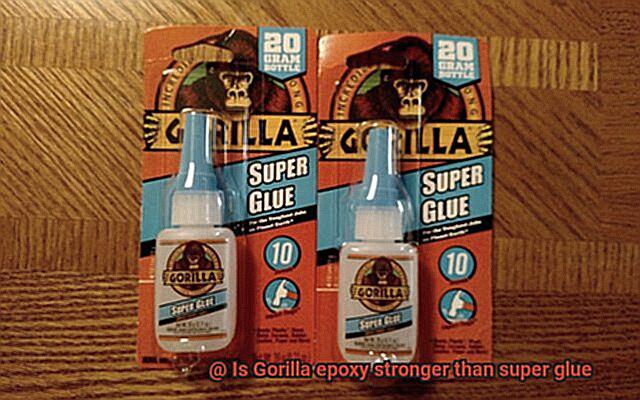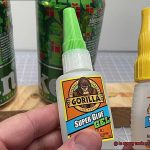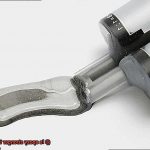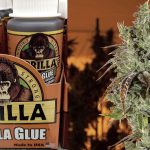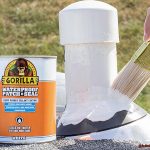Are you tired of projects falling apart shortly after completion? Are you looking for an adhesive that can handle a heavy-duty job and provide a long-lasting hold? Look no further than Gorilla epoxy and super glue. But which one is stronger?
In this blog post, we’ll be exploring the differences between these two popular adhesives and determining which one reigns supreme in terms of strength. From the science behind their bonding abilities to real-world tests, we’ll cover it all.
Whether you’re a DIY enthusiast or a professional contractor, choosing the right adhesive for your project is crucial. Don’t waste time and money on an adhesive that won’t hold up. Instead, let us guide you to the best option for your needs.
So sit back, relax, and get ready to learn everything you need to know about Gorilla epoxy vs super glue. Let’s dive in.
The Difference between Gorilla Epoxy and Super Glue
Contents
- 1 The Difference between Gorilla Epoxy and Super Glue
- 2 Advantages of Gorilla Epoxy over Super Glue
- 3 Disadvantages of Gorilla Epoxy compared to Super Glue
- 4 Factors Affecting the Strength of Bond Created with Adhesives
- 5 Applications Where Gorilla Epoxy is Recommended Over Super Glue
- 6 Applications Where Super Glue is Recommended Over Gorilla Epoxy
- 7 Tips for Choosing the Right Adhesive for Your Project
- 8 Conclusion
When it comes to choosing the right adhesive for your needs, it’s important to understand the differences between Gorilla Epoxy and Super Glue. While both serve the same purpose of bonding materials together, they have distinct properties and performance capabilities.
Super Glue, also known as cyanoacrylate glue, is a popular choice for quick and easy repairs. It creates an instant bond by reacting with moisture in the air and is perfect for small repairs such as fixing broken ceramics or bonding plastic parts. However, Super Glue can be limited when it comes to heavy-duty materials like metal or wood.
On the other hand, Gorilla Epoxy is a two-part adhesive that consists of resin and hardener. When mixed together, they form a strong bond that can withstand heavy loads and extreme temperatures. Gorilla Epoxy is ideal for bonding materials such as metal, ceramic, glass, wood, and plastic. It’s also waterproof and can be sanded or painted over once it dries.
One of the main differences between Gorilla Epoxy and Super Glue is their strength and durability. Gorilla Epoxy is much stronger than Super Glue and can hold up under heavy loads without breaking or coming apart. Super Glue, on the other hand, is not as strong and can break easily under stress.
Another difference between these two adhesives is their application process. Super Glue is easy to use with its precision applicator and requires no mixing or preparation. Gorilla Epoxy, on the other hand, requires mixing of the resin and hardener before application. It also has a longer curing time compared to Super Glue.
It’s important to note that the effectiveness of both adhesives depends on various factors such as the types of materials being bonded, the surface area, and the amount of adhesive used. In some cases, Super Glue may be strong enough for certain applications while Gorilla Epoxy may be necessary for others.
Advantages of Gorilla Epoxy over Super Glue
When it comes to finding the perfect adhesive for your project, you need to consider the advantages each product offers. Although Super Glue might be a popular choice for quick fixes, Gorilla Epoxy has some serious benefits that make it stand out from the crowd.
Strength is one of the primary reasons why Gorilla Epoxy takes the lead. This two-part adhesive consists of resin and hardener, creating a bond that can hold up to 4250 PSI. Its impressive strength makes it the perfect adhesive for heavy-duty applications such as construction or automotive repairs.
Versatility is another advantage of Gorilla Epoxy over Super Glue. While Super Glue works best on non-porous surfaces like metal or plastic, Gorilla Epoxy can be used on a wide range of materials such as wood, ceramics, and even concrete. This versatility makes it an ideal adhesive for various projects.
Resistance is yet another area where Gorilla Epoxy excels. It’s designed to withstand exposure to water and heat without losing its strength or breaking down over time. This feature makes it perfect for use in outdoor or high-temperature applications where other adhesives might fail.
Working Time is crucial in adhesive selection, and Gorilla Epoxy offers a longer working time compared to Super Glue. While Super Glue sets almost instantly, Gorilla Epoxy gives you more time to adjust and position your materials before it sets. This can be a game-changer when working on larger or more complex projects.
Disadvantages of Gorilla Epoxy compared to Super Glue
Today, we’re going to explore the disadvantages of Gorilla Epoxy compared to Super Glue. While Gorilla Epoxy is often hailed as the superhero of adhesives due to its strength and durability, it’s not without its drawbacks. Let’s dive in and take a closer look at some of these drawbacks.
One major disadvantage of Gorilla Epoxy is its longer curing time compared to Super Glue. While Super Glue sets almost instantly, Gorilla Epoxy can take hours or even a full day to fully cure. This can be frustrating for those who need a quick fix or don’t want to wait around for their project to dry. The longer curing time is especially problematic when working on time-sensitive projects.
Another potential drawback of Gorilla Epoxy is its messiness factor. Unlike Super Glue, which typically comes in a convenient tube or pen applicator, Gorilla Epoxy requires mixing two different substances together before applying. This can be messy and time-consuming, and may not be ideal for those who prefer a more straightforward application process. The mixing process can also lead to imprecise measurements, which could negatively impact the adhesive’s effectiveness.
Furthermore, Gorilla Epoxy can be more difficult to remove if applied incorrectly or in the wrong spot. While Super Glue can often be dissolved with acetone or nail polish remover, Gorilla Epoxy may require more extensive removal methods, such as sanding or scraping. This makes correcting mistakes or making adjustments more challenging and time-consuming.
Factors Affecting the Strength of Bond Created with Adhesives
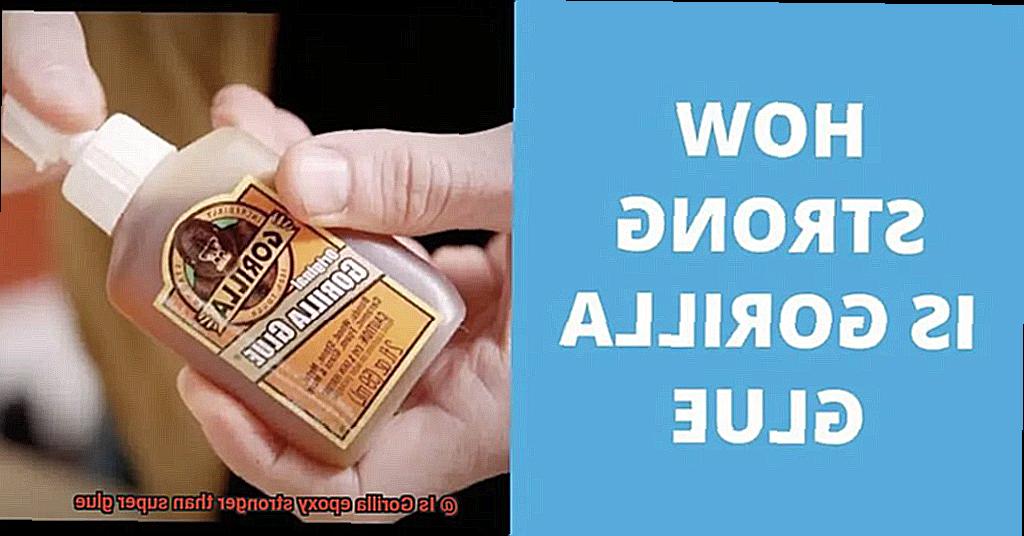
Let’s explore these factors and learn how to select the right adhesive for your needs.
Firstly, surface preparation is critical to achieving a strong bond. A dirty or oily surface can hinder the adhesive’s ability to bond effectively. To ensure a clean and even surface, it’s crucial to clean and dry the area thoroughly before applying any adhesive. Additionally, sanding or roughening the surface can significantly improve adhesion.
The type of adhesive used is also a crucial factor. Super glue is a quick fix but may not be as durable as other types of adhesives. Gorilla epoxy, on the other hand, takes longer to cure but creates a stronger and more durable bond. So, depending on the application, it’s important to choose the right adhesive type.
Lastly, curing time is another factor that cannot be ignored. Some adhesives may form a quick bond, but they may not fully cure for several hours or even days. It’s crucial to follow the manufacturer’s instructions regarding curing time and avoid putting stress on the bond until it has fully cured.
Applications Where Gorilla Epoxy is Recommended Over Super Glue
Choosing the right adhesive is crucial when working on a project, just like building a house requires a solid foundation. That’s why it’s important to know when to use Gorilla epoxy over super glue.
Firstly, Gorilla epoxy is perfect for automotive repairs, especially when fixing engine parts or components that undergo high temperatures and intense vibrations. This adhesive can withstand these conditions, ensuring your repairs last. Super glue, on the other hand, may not hold up under such stresses.
In woodworking, Gorilla epoxy is also the preferred adhesive. It can create a strong bond between pieces of wood by filling gaps or joints. Super glue may seem like a quick fix but can become brittle over time and won’t hold up under stress.
Additionally, Gorilla epoxy is an excellent choice for bonding materials such as metal, ceramic, and plastic due to its longer working time. This allows for adjustments to be made before the adhesive sets firmly. In contrast, super glue dries quickly and doesn’t offer enough time for precision in these types of applications.
Applications Where Super Glue is Recommended Over Gorilla Epoxy
While Gorilla epoxy is a common choice for tough applications like automotive repairs or woodworking, certain cases call for super glue to take the lead.
If you’re working with non-porous materials such as plastic or metal, super glue should be your go-to adhesive. It forms a strong and almost instant bond with these types of materials, which makes it a popular choice for small repairs or DIY projects. Additionally, it’s easy to use and dries quickly, so you can get back to your project in no time.
Another advantage of super glue is its flexibility. If you need to bond materials that require some give and take, then super glue is your best bet. Gorilla epoxy can be quite rigid once it has cured and may not be suitable for materials that require some flexibility.

Furthermore, when dealing with small gaps between materials, super glue is the way to go. Unlike Gorilla epoxy, which requires a precise mix ratio of resin and hardener to achieve optimal bonding strength, super glue can easily fill those small gaps between materials.
Tips for Choosing the Right Adhesive for Your Project
When it comes to selecting the perfect adhesive for your project, there are several factors that you need to consider. Here are five sub-sections of factors that can affect the strength and durability of your bond.
Material Compatibility
One of the most crucial factors to consider is the material that you will be bonding. Certain adhesives work better on specific materials than others. For example, super glue is ideal for non-porous materials like plastics, metals, and ceramics, while wood glue is a better option for porous materials like fabric or wood. Gorilla epoxy, on the other hand, can bond a wide range of materials, including metal, plastic, ceramic, and more.
Strength Requirements
The strength required for your project also plays a vital role in choosing the right adhesive. Super glue has a fast-drying property and creates a strong bond but may not be sturdy enough for heavy-duty applications. Gorilla epoxy is a two-part adhesive that creates an incredibly robust bond that can withstand heavy loads and vibrations.
Environmental Factors
You should consider the environment in which your project will be exposed to when choosing an adhesive. If your project will be exposed to moisture or extreme temperatures, you need an adhesive that can withstand these conditions. Gorilla epoxy is waterproof and heat-resistant up to 200 degrees Fahrenheit, making it an excellent choice for outdoor or rugged applications.
Application Method
The application method is another crucial factor when selecting an adhesive. Some adhesives come in tubes or bottles with precision tips that make it easy to apply in tight spaces. Others require mixing or special applicators. Choose an adhesive that fits your project’s needs and is easy to apply.
Specific Requirements or Limitations
Finally, you should consider any specific requirements or limitations of your project when choosing an adhesive. For example, if you need an adhesive that dries clear or remains flexible after drying, you should look for an adhesive that meets those requirements.
Conclusion
In summary, selecting the appropriate adhesive for your project is critical to achieving a robust and long-lasting bond. Gorilla epoxy and super glue are two popular options that serve the same purpose of bonding materials together but have distinct properties and performance capabilities. While super glue is ideal for quick fixes, Gorilla Epoxy is a two-part adhesive that creates a bond strong enough to withstand heavy loads and extreme temperatures.
Gorilla Epoxy outshines Super Glue in several ways, including its strength, versatility, resistance to water and heat, and longer working time. However, it also has some downsides such as longer curing time, messiness during application, and difficulty in removal if applied incorrectly.
The strength of the bond created with adhesives depends on surface preparation, type of adhesive used, and curing time. Therefore it’s crucial to choose the right adhesive based on material compatibility, strength requirements, environmental factors, application method, and specific project requirements or limitations.
Ultimately both Gorilla Epoxy and Super Glue have their strengths and weaknesses depending on the project’s needs. By comprehending their differences and considering all factors involved in selecting an adhesive for your project, you can make an informed decision that will result in a successful outcome.

